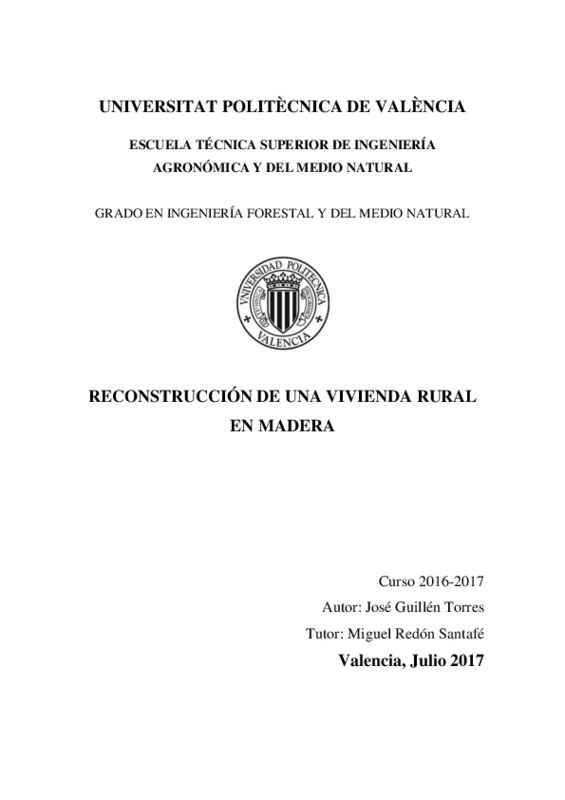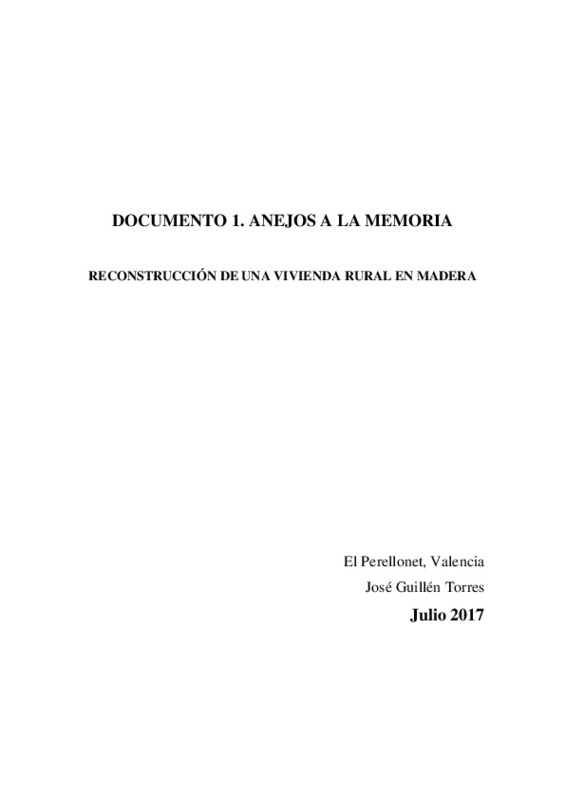JavaScript is disabled for your browser. Some features of this site may not work without it.
Buscar en RiuNet
Listar
Mi cuenta
Estadísticas
Ayuda RiuNet
Admin. UPV
Reconstrucción de una vivienda rural en madera
Mostrar el registro sencillo del ítem
Ficheros en el ítem
| dc.contributor.advisor | Redón Santafé, Miguel
|
es_ES |
| dc.contributor.author | Guillén Torres, José
|
es_ES |
| dc.date.accessioned | 2017-09-15T12:31:39Z | |
| dc.date.available | 2017-09-15T12:31:39Z | |
| dc.date.created | 2017-07-25 | |
| dc.date.issued | 2017-09-15 | es_ES |
| dc.identifier.uri | http://hdl.handle.net/10251/87352 | |
| dc.description.abstract | [ES] La siguiente información tiene como objeto definir breve y concisamente los aspectos más generales del trabajo que se llevará a cabo. El proyecto consiste en la reconstrucción de una vivienda de campo, situada en la pedanía de el Perellonet, Valencia, a 20 km aproximadamente de la capital y construida dentro de un terreno agrícola. Pese a su buen estado estético exterior, se comienza a apreciar ciertos deterioros progresivos en el interior de la vivienda debido al paso del tiempo y a la falta de mantenimiento. Es por ello que se plantea reestablecer una nueva estructura base utilizando como material la madera laminada. Con este proyecto se pretende reacondicionar la vivienda dando la posibilidad de establecerla como alojamiento para un uso recurrente, generando el menor impacto ambiental posible gracias al uso de la madera como material estructural base y dotándola de los recursos mínimos necesarios, energía y agua, para poder llevar a cabo dicho propósito. Se establecerá una vivienda de dos plantas: planta baja y planta superior. En la planta superior se diseñará una terraza al aire libre, la cual tendrá un carácter de uso transitable, un dormitorio y un cuarto de baño. Esta zona se encontrará cerrada y con una cubierta a un agua. La planta baja estará destinada a la proyección de un salón, un cuarto de baño y una cocina. Por tanto, el principal objetivo que se persigue llevando a cabo este proyecto es la rehabilitación de la vivienda, que actualmente no se encuentra en condiciones de dar el servicio deseado, utilizando materiales que creen un bajo impacto ambiental y dotarla de los recursos básicos necesarios para hacer de ella una vivienda confortable, estéticamente agradable y energéticamente eficiente. Por último, cabe destacar el gran beneficio indirecto que presenta el uso de la madera como material estructural, pues su contribución frente a la reducción de emisiones de CO2 junto a la eficiencia térmica que aportan hace de ella el material sustituto líder frente a los materiales utilizados convencionalmente. | es_ES |
| dc.description.abstract | [EN] The following information is intended to briefly and concisely describe the more general aspects of the work to be carried out. The project consists of the reconstruction of a country house, located in the hamlet el Perellonet, Valencia, 20 km approximately from the capital and built within an agricultural land. In spite of its good external aesthetic state, it begins to appreciate certain progressive deteriorations in the interior of the house due to the passage of time and the lack of maintenance. This is why it is proposed to reestablish a new base structure using as laminated wood material. This project aims to recondition the housing giving the possibility of establishing it as a housing for a recurring use, generating the least possible environmental impact thanks to the use of wood as the basic structural material and providing it with the necessary minimum resources, energy and water, in order to to carry out this purpose. A housing will be established on two floors: ground floor and upper floor. On the upper floor will be designed an outdoor terrace, which will have a useable character, a bedroom and a bathroom. This area will be closed and covered with water. The ground floor will be designed for the projection of a living room, a bathroom and a kitchen. Therefore, the main objective pursued by this project is the rehabilitation of housing, which is not currently able to provide the desired service, using materials that create a low environmental impact and provide it with the basic resources necessary to Make it comfortable, aesthetically pleasing and energy efficient. Finally, it is worth mentioning the great indirect benefit of the use of wood as a structural material, since its contribution to the reduction of CO2 emissions together with the thermal efficiency they provide makes it the substitute material leading to the materials used conventionally. | es_ES |
| dc.format.extent | 413 | es_ES |
| dc.language | Español | es_ES |
| dc.publisher | Universitat Politècnica de València | es_ES |
| dc.rights | Reserva de todos los derechos | es_ES |
| dc.subject | Rehabilitation | es_ES |
| dc.subject | Wood construction | es_ES |
| dc.subject | Energy efficiency | es_ES |
| dc.subject | Rehabilitación | es_ES |
| dc.subject | Construcción en madera | es_ES |
| dc.subject | Eficiencia energética | es_ES |
| dc.subject.classification | INGENIERIA AGROFORESTAL | es_ES |
| dc.subject.other | Grado en Ingeniería Forestal y del Medio Natural-Grau en Enginyeria Forestal i del Medi Natural | es_ES |
| dc.title | Reconstrucción de una vivienda rural en madera | es_ES |
| dc.type | Proyecto/Trabajo fin de carrera/grado | es_ES |
| dc.rights.accessRights | Abierto | es_ES |
| dc.contributor.affiliation | Universitat Politècnica de València. Escuela Técnica Superior de Ingeniería Agronómica y del Medio Natural - Escola Tècnica Superior d'Enginyeria Agronòmica i del Medi Natural | es_ES |
| dc.contributor.affiliation | Universitat Politècnica de València. Departamento de Ingeniería Rural y Agroalimentaria - Departament d'Enginyeria Rural i Agroalimentària | es_ES |
| dc.description.bibliographicCitation | Guillén Torres, J. (2017). Reconstrucción de una vivienda rural en madera. http://hdl.handle.net/10251/87352. | es_ES |
| dc.description.accrualMethod | TFGM | es_ES |
| dc.relation.pasarela | TFGM\66577 | es_ES |
Este ítem aparece en la(s) siguiente(s) colección(ones)
-
ETSIAMN - Trabajos académicos [3541]
Escuela Técnica Superior de Ingeniería Agronómica y del Medio Natural







